In recent weeks, fate has taken me into the Boston area on several occasions to spend time there with a farmer ,a forester and a faucet.
On Saturday, I dragged myself from an afternoon snooze. Between that and a looming business trip commencing Sunday morning, I knew I had to fit in an errand to Boston to shut off a valve on a dam. As we wound down the hill between the trees in the gathering gloom of the front that was curling in from the South, I spotted the dam in the distance. Even from there I began to beam at our success in dropping the level. We could see the baseline of the reeds, contrasting with the green tops, and indicating that the water was well down. On arrival at the shelter I could see the poles, which a week and a half earlier had barely protruded from the water, and which now stood high and dry.
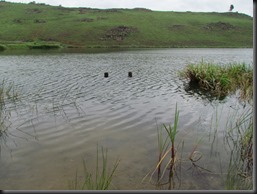
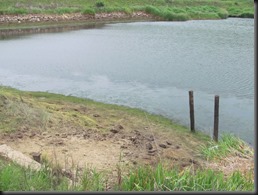
Normally a low water level is not something to celebrate, but these are special circumstances . Here we are dropping the water level as the temperature rises through the magical 18/19 degrees C level. This is when the Bass lay their eggs, and within 7 to 10 days, we need to get them out in the hot sun, before they have a chance to hatch. The valve had been opened 9 days earlier, and I had inspected the dam after 24 hours, at which time it was just 25cms down. Then during the week we had some decent rainfall, and a fishing club member reported the dam full despite the water pouring out through the faucet.
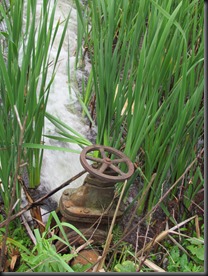
Fortunately I came to check before I headed off to Central Africa, because if I hadn’t we might have over-done it, and killed the Trout too!
I scrambled down the wall and swung the squeaky wheel on the valve. As I did so, there was a flash of light against the black sky, and I looked up to see if my wife had taken a photo. The question was answered before it had fully developed in my mind, by an almighty BANG. I scrambled up the wall and we sprinted for the safety of the bakkie!
The week before I had dropped in on the forester, Obed Sibiya . Running an estate of this size is a considerable undertaking, and I waited patiently while Obed took several pressing calls.

Then we chatted about the Trout, and the invasion of Bass. I explained that while Trout and Bass are both alien species, the Trout is far from invasive, having to be actively stocked in still-waters, where they do not breed, all the while competing with the Bass that do. We discussed the range of Bass that includes all the warm water areas, and the significantly more limited range of the Trout in cold waters, and I had my usual rant and rave about how once Bass get in, a Trout water is lost forever. Obed lit in recognition of the issue when I compared the Bass to the wattle trees, brambles and “Bonga Bonga”, that he, as a dedicated forester, fights the entire year.
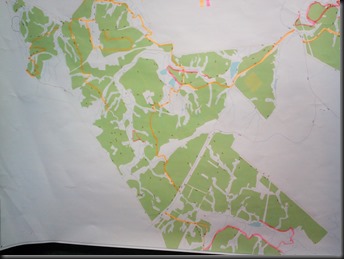
The estate under Obed’s charge is home to the delicate upper Elands river, between where it exits the highland estate of Tillitudlem, and forms a larger stream in the pastoral valley to the East.
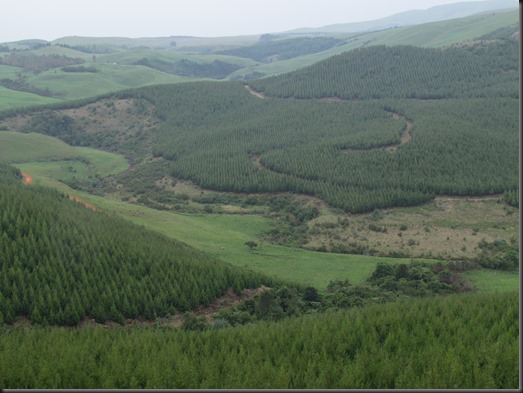
This is a slender slither of water that is the breeding ground of the Trout that swim the Elands lower down, and they are none too plentiful there. This reflects the degree to which our dry winters impact on the ability of these small becks to sustain a breeding population of fish.
From Obed’s office I made my way to Pete the Pirate (“But Dad, you can’t call him that” chorused my kids a number of years back when Pete and I re-acquainted noisily in a supermarket aisle)
Pete’s kettle turns on automatically when you turn in to the parking lot of his shop. We stood there sipping coffee and talking Trout stocking, while finches flitted between us to steal the maize meal that Pete sells. We had just stocked a new club dam in the Boston area, that Pete had previously stocked for the farmer as part of the Boston Festival (Pete arranges this wonderful event every year). The generous introduction of the water to the club by the farmer (another Pete!) had necessitated a map drawing visit by Graeme, Jim, Dave and I. We drank some coffee there too, and chatted about fly-fishermen’s etiquette, stock theft, and the Boston Fly Fishing Festival. A week later a batch of Trout found their way from the hatchery off to the North, into that small lake. We had put in about 425 two inch fish per hectare, in place of the previous rate which was somewhat lower.
“We need to stock for results throughout the year” I explained. “Not a single annual week-end. It requires a slightly different approach”. We dodged the passing forklift as Pete called out to his assistant to estimate the size of another farmer’s water over the hill. But that dam has Bass in it too. We resolved to see how our experiment goes on Obed’s water, but in the meantime to pursue a “keep all Bass” policy, stock with Bass guzzling 9” Trout at hatching time, look at spillway screens, and look to see if the dam has a valve for water lowering purposes.
I have a few crazy ideas of my own on how to give the Trout the upper hand in this battle, including shades on floats , and Bass decoys, but I kept those to myself and pulled quickly out of Pete’s driveway to head back to town, for fear of being labeled a complete anti-Bass nut!
8 Responses
I’ve never heard of bass as an invasive species. Interesting post.
I guess it depends on the context. Here Bass are not a native species, and they have a nasty habit of spreading to new waters, as though they pollinate by wind!
Wonderfully written piece Andrew. Well done.
Thank you Tim
Hi Andrew, My Father farms in Boston and although our dam had trout in it to start bass are slowly taking over, we recently stocked 10 inch trout in the hope that the survival rate would be higher than stocking fry. Your theory of lowering the water level to kill the bass eggs sounds very interesting and would like to try it on our water. What time of the year would you suggest we try this, or should we just keep checking water temp and lower it when it gets above 18degress? Then how long should we keep the level down? Sorry for all the questions but at a point when we would try anything to slow the ever increasing number of bass down
Hi Jared. The 10 inch Trout will be at an advantage over the bass, so that is a good move. The water should be at 18 degrees around late October, when you will see breeding bass in the shallows. You just need to drop the water to expose the eggs. Then you can let it fill up again. Maybe even repeat the exercise straight after.
Thanks Andrew, we will definitely try this. appreciate the advice and all the great reads on your blog
Glad to be of help Jared